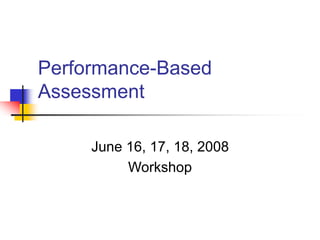
Performance Assessment Workshop
- 1. Performance-Based Assessment June 16, 17, 18, 2008 Workshop
- 2. Goals for the Workshop Gain knowledge and understanding of performance based assessment (PBA) Analyze and distinguish effective PBAs from less effective PBAs Apply workshop concepts to develop effective performance-based assessment tasks and associated scoring rubrics
- 3. An Introduction Why? What? How?
- 4. 3 Day Progression… Day 1: Interactive Input Day 2: Guided Practice Day 3: Independent, but collaborative, Practice
- 5. Why? “Ultimately, we want students to grow to be independent. For them to do that, they have to have a sense of what the criteria (are) that make them successful. For a long time, the criteria (have) been a mystery to students…” R.J. Tierney, M. Carter, & L. Desai Portfolio Assessment in Reading-Writing Classroom
- 6. Student assessment should be grounded in the authentic, real-life activities that are carried out in the classroom. Because effective language learning is meaningful, enjoyable, and interactive, assessment should reflect a similar focus… Students engaged in this process become more and more actively involved in their learning. (Armstrong, 1998, p. 233)
- 7. Table Discussion Topic At your tables discuss the following questions: Why Performance-Based Assessment? What are advantages? Disadvantages? Potential pitfalls &/or challenges Summarize your discussion on an transparency sheet.
- 8. Report out
- 9. “People still think that assessment is what you do after teaching and learning are over as opposed to thinking of assessment as giving feedback to help you to achieve your goal.” —Grant Wiggins, Educational Consultant
- 10. What is Performance-Based Assessment (PBA)? Monitors students’ progress in relationship to learner outcomes Requires students to create answers or products/presentations/performances demonstrating their knowledge and skills applicable for real-life based purposes Differs widely from traditional testing (single answer or fill in the blank).
- 11. PBA - Some Key Points It takes time to develop, implement, refine, and get to that “comfort” zone in using PBA BUT THE PAY OFF IS TREMENDOUS!
- 12. Key Point #1 Instructional design and decisions should start with assessment What do we want students to learn? How will we know when they have learned it? How will I use the results?
- 13. Key Point #2 Students should know the criteria and what’s expected UP FRONT. Performance-based task Scoring Guides (rubrics) Exemplars of “excellent” work
- 14. Key Point #3 Practice, practice, practice… improves performance! Research supports the notion that all students (especially low achievers) will improve when given multiple opportunities to practice When students feel “successful & hopeful” their motivation & performance increase
- 15. Key point #4 - Knowing the targets, feedback, & reflection Function Frameworks & LinguaFolios “…when students are informed about the learning targets from the beginning, engage in self-assessment, keep track of and regularly reflect on their own growth, and play a role in communicating their learning-the achievement gains are profound, especially for low achievers.” (Rick Stiggins, ETS)
- 16. Key Point #5 Curriculum-embedded performance and “on demand” performance are not equal… Students tend to perform higher in classroom activities, then they do when assessment is “on demand” WYSI (not) WYG
- 17. Key Point #6 Assessment is ongoing - all the time. What are some examples of ongoing continuous assessment? Informs instructional decisions
- 18. Key Point #7 Instruction and assessment should be congruent. Proficiency-oriented instruction should be matched with proficiency-based assessment
- 19. Key Point #8 Student Involvement: A sound assessment system involves students in self-assessment, recording keeping, and/or communication.
- 20. Instruction, Outcomes, Assessment “Meaningful involvement of students with material that is central to the teaching objectives of a given course. For this meaningful involvement to take place, the goals of the assessment tasks need to reflect the goals of the course, and these goals need to be made clear to the students.” (Cohen, 1994).
- 21. Course Goals Essential Learnings National Standards State & District Standards Function Frameworks
- 22. How… Keys to Success (Rick Stiggens, ETS) All assessments must center on high quality standards All assessments must yield accurate evidence of achievement All users must understand results and use them productively
- 23. Characteristics of Effective PBA Tasks Students are active participants Intended outcomes are clearly identified & guide the design of the performance task Students are expected to demonstrate mastery of those intended outcomes when completing the task
- 24. Effective PBA Tasks (2) Students demonstrate their ability to apply knowledge & skills to real-life based situations & scenarios A clear, logical set of P-B activities are evident Clear set of criteria to judge the performance
- 25. PBAs - 3 points Good tasks do 3 things… Content of the Task - What information do students need? Sampling - Is there enough evidence? Distortion Due to Bias - What can interfere with accuracy?
- 26. Designing PBA Tasks 1. Identifying Outcomes & Indicators 2. Creating a Meaningful Task Context 3. Identifying Products &/or Performances 4. Considering options in task design
- 27. Designing PBA Tasks (cont.) 5. Planning task activities 6. Identifying Evaluative Criteria 7. Generating an Exemplary Response 8. Making Decisions about Scoring
- 28. A Word About Rubrics… Be understandable to students Be aligned with standards Be illustrated with samples of student work Be concise Be worded in a positive manner Match the task Define various levels of performance Include the same features across various levels of performance
- 29. As they say, two heads are better than one!